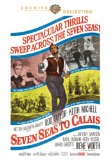| Reviews & Columns |
|
Reviews DVD TV on DVD Blu-ray 4K UHD International DVDs In Theaters Reviews by Studio Video Games Features Collector Series DVDs Easter Egg Database Interviews DVD Talk Radio Feature Articles Columns Anime Talk DVD Savant Horror DVDs The M.O.D. Squad Art House HD Talk Silent DVD
|
DVD Talk Forum |
|
|
| Resources |
|
DVD Price Search Customer Service #'s RCE Info Links |
|
Columns
|
|
|
Seven Seas to Calais
"I'm surprised...you're an ordinary man. From the reports I received I expected a giant."
Energetic Italian Cappa e spada peplum, with a solid cast. Warner Bros.' terrific Archive Collection, the M.O.D. (manufactured on demand) service catering to movie and TV lovers looking for those hard-to-find cult and library titles, has released Seven Seas to Calais (original title: Il dominatore dei sette mari), the 1962 Italian swashbuckler released by Metro-Goldwyn-Mayer starring Rod Taylor, Keith Michell, Antony Dawson, Hedy Vessel, Terrence Hill, and Irene Worth. Weaving a fanciful, comic-book version of Sir Francis Drake's "Singeing the King of Spain's Beard" and the subsequent repulsion of the Spanish Armada at the Battle of Gravelines, Seven Seas to Calais sports a fair amount of swordplay, fun, juvenile model work in the final fiery naval battle, and some amusing byplay from the talented cast. An original trailer is included in this okay-looking widescreen transfer.
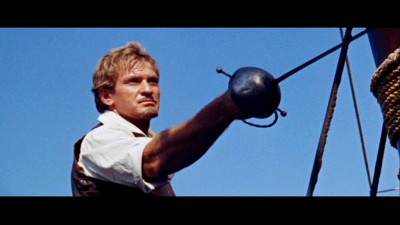
According to screenwriter Filippo Sanjust...in Plymouth, England, in 1577, adventurer Malcolm Marsh (Keith Michell), aiding a man fleeing from Spanish guards, gets his hands on a map outlining all the Pacific ports where Spain, England's mortal enemy, has hidden her gold. Heeding the dying man's words ("If you love England..."), Marsh takes the map to notorious-but-patriotic privateer Sir Francis Drake (Rod Taylor), who kills the remaining Spanish guards who have seriously wounded Marsh. Meanwhile, in London, Queen Elizabeth (Irene Worth) is reassuring the Spanish ambassador, Don Bernardino de Mendoza (Arturo Dominici), that pirates like Drake will be severely punished for raids on Spanish ships―a promise she enforces by sending an astonished Drake to the Tower of London. Satisfied, the ambassador leaves...and Drake is led right back down the hall to the Queen, who has a three year mission for him: harass the Spanish fleet and bring her back as much booty as possible ("See that you bring me a good profit."). Marsh signs on as Drake's second, which annoys his lovely consort, Arabella Ducleau (Hedy Vessel), and soon the boys are off to "singe the beard of the King of Spain," fighting off their own mutineers when water becomes scarce, raiding South American mines of Spanish gold, and capturing the Port of Cadiz. While Drake gets high on, um...South American "tobacco," and Marsh accidentally marries native girl Potato (Rossella D'Aquino), back in England, Arabella's new fiancé, Babington (Terrence Hill) uses the unwitting Arabella to facilitate a Spanish assassination plot against Elizabeth in order to put Catholic Mary, Queen of Scots (Esmeralda Ruspoli) on the English throne. Oh, and the Spanish Armada sails in and has to be blown up.
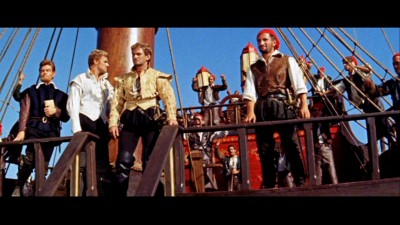
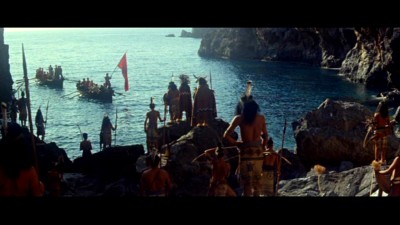
The "sword and sandal" pepla from Italy are probably the most familiar subgenre of the Italian historical/mythological/Biblical costume epics that flooded international screens from the late 1950s (particularly after the astounding success of Steve Reeves' Hercules in 1959) until the spaghetti westerns took over in the mid-60s. However, quite a few other subgenres were hurried out, many with the help of Hollywood money, either in the form of co-production costs, releasing arms, or in casting and crews. Seven Seas to Calais, a swashbuckler or Cappa e spada, was released through M-G-M here in the States, and starred contract player Rod Taylor, so perhaps Metro had some skin in the production side here, as well. Countless pepla titles of varying subgenres came out during this period, with varying budgets (from miniscule to barely adequate) and sometimes starring "name" Hollywood actors, either on their way up or down...or pending. Just a few of the Cappa e spada were: Rage of the Buccaneers, starring Vincent Price; Revenge of the Musketeers, starring Fernando Lamas; The Adventurer of Tortuga, starring Guy Madison; The Black Duke and Massacre in the Black Forest, starring Cameron Mitchell; The Count of Monte Cristo, starring Louis Jourdan; Duel of Champions, starring Alan Ladd; Mask of the Musketeers, starring Gordon Scott; The Black Lancers, starring Mel Ferrer; The Castilian, starring Cesare Romero; and Pirates of the Coast, Robin Hood and the Pirates, Son of the Red Corsair, and The Pirate and the Slave Girl―all starring Lex Barker. With cheap pick-up and/or production costs for the releasing companies, and a minimum of some flashy, sensationalized marketing, it was difficult to lose money on these unassuming exploitation products (even if M-G-M had somehow put up Seven Seas to Calais' entire $650,000 budget...they made it back 3 ½ times at the American box office alone).
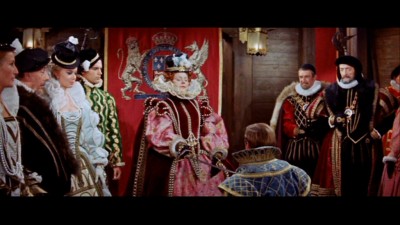
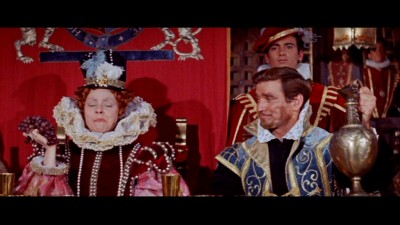
Even though several sources list him as a co-director, I couldn't find any definitive info on how much Italian director Primo Zeglio (Morgan, The Pirate, The Restless Four) actually had to do with Seven Seas to Calais. Hollywood veteran Rudolph Mate (D.O.A., When Worlds Collide, The Far Horizons, and the same year's terrific peplum, The 300 Spartans with Richard Egan) has solo on-screen credit, so any pepla experts out there who know if Zeglio did just the second-unit work, or translated for Mate to the Italian crew...or directed the whole thing while Mate had a drink at his hotel bar, let me know. What I do know is that Seven Seas to Calais doesn't waste any time screwing around with anything inconvenient like real history or complex character motivations (colorful but apocryphal incidents like the Queen herself knighting Drake and Drake's famous uninterrupted game of bowls prior to the Armada landing, are included for fun...not for scholars). It just gets on with it, which is just what a fast, cheap peplum is supposed to do.
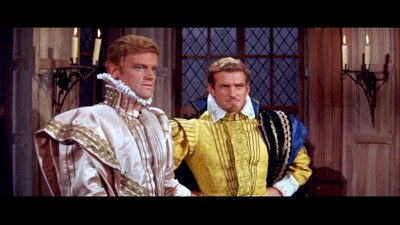
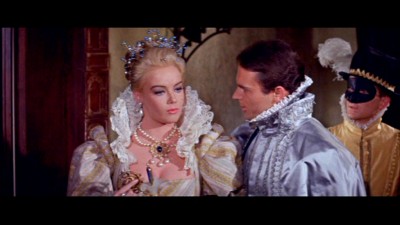
According to Sanjust and Mate (and maybe Zeglio), the fascinating dynamics of Queen Elizabeth I's double-dealing endorsement of Sir Francis Drake's privateering against England's enemy Spain was nothing more than Rover Boys comic book-style hokum in the service of profit and adventure...and who's to say the "real" history of those events, at their most fundamental core, weren't really just that? The movie opens right up on action―the chase for the gold map and two extended sword fights―and never lets up. The budget is limited, to be sure, so major action scenes sometimes get cut off right just when they should start to build (the raid on the Port of Cadiz), or are eliminated outright (the off-screen sea storm that supposedly killed Drake and his men). There's only one big set, the South American gold mine, but it's unimaginatively dressed, with the subsequent fight scene chaotically choreographed. We get a few shots of a big ship at sea, but those could be stock shots lifted from anywhere (we never actually see Taylor and the crew onboard at full sail, either; he's just shot topside, with the ship obviously anchored in calm waters). Certainly, Seven Seas to Calais' big guns are saved for the final assault on the Spanish Armada, and while one may snigger at the primitive model work here, it really isn't all that much worse than model work you'll find in the naval scenes for Ben-Hur or the same year's multi-million dollar extravaganza, Cleopatra. The supposedly imposing Armada may look like a bunch of bathtub toys, but the multiple explosions and light flashes are furious, and in the end...what viewer who wanted to blow up their toys as a kid wouldn't enjoy this silly battle?
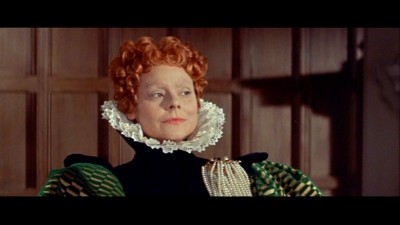
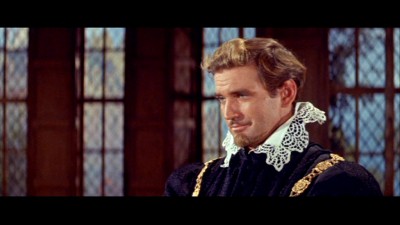
When Seven Seas to Calais isn't fighting, it's frequently (and surprisingly) amusing. When Keith Michell (TV's The Six Wives of Henry VIII and Murder, She Wrote) manages to tear himself away from the voluptuous charms of Hedy Vessel (The Trojan Horse, The Thief of Baghdad), he takes a beautiful pratfall right over the side of the boat, with the sailors laughing appreciatively. And when Mate stages the assault on the gold mine, the music plink-plinks along at an appropriately comedic clip. Even better are the humorous, bantering court scenes between Taylor and stage luminary Irene Worth. Worth's Queen Elizabeth I―foxy, avaricious―verbally spars with Taylor's Drake like a combination Margret Dumont and Myrna Loy: imperious and indulgent of their shared diplomatic/privateering pranks at one moment ("We're both pirates, Drake"), and then sly and almost sexy the next, responding to Drake's physicality and obvious veneration for her (when she speaks of that one night when Drake offered her "comfort," are the scripters suggesting the two were lovers?). Taylor's brash, earthy Australian manner is just right for the splashy derring-do of rambunctious Drake. He may not be the most graceful of on-screen fencers I've seen (he needs to keep his arms in more), but he attacks his action scenes with vigor, while keeping his face mostly straight during the funny dialogue passages (if reports are true that he was dating 8th Wonder of the World Anita Ekberg at the time of filming...one can certainly excuse―and envy―his occasionally bedraggled, exhausted appearance here). In keeping with Seven Seas to Calais's unexpected pleasures, Taylor's final fade-out is appropriately heroic. As Keith Michell tries to tear himself away from the sight of Taylor bestride the departing bow of his ship, Michell recites, "To endure to the end of a voyage. To reach land and taste its comforts. To have the courage to go to sea again. That is the true glory." Hedy Vessel looks at him skeptically and asks, "And who said that?" to which Michell responds in a wonderfully funny, self-reflexive tone, "Sir Francis Drake!" as the camera cuts to Taylor, looking suitably grim and gallant. Now that's how comic book movies should end.
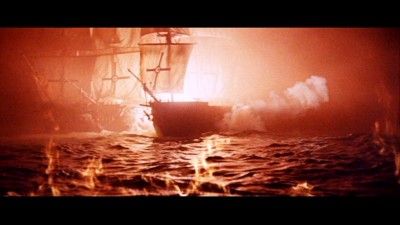
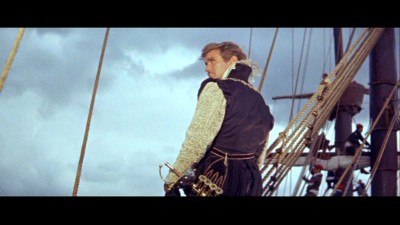
The DVD:
The Video:
The anamorphically-enhanced, 2.4:1 widescreen transfer for Seven Seas to Calais looks...just okay, with a distinctly reddish, faded color scale, quite a bit of grain, a soft picture in the mid-range, and numerous print anomalies. Not the best...but at least it's widescreen.
The Audio:
The Dolby Digital English split mono audio track is acceptable, with a minimum amount of hiss, and clean dialogue. No closed-captions or subtitles.
The Extras:
An original trailer is included here. Nice.
Final Thoughts:
Zippy, amusing Cappa e spada peplum. Seven Seas to Calais says, "Screw history...let's get on with the action," and thank god for that. Surprisingly witty scripting, top-notch players for this sort of exploitation, and speedy execution (to cover the budget holes). You can keep your overpriced, over-CGI'd, overrated Disney Pirates crap. I'm highly recommending Seven Seas to Calais.
Paul Mavis is an internationally published movie and television historian, a member of the Online Film Critics Society, and the author of The Espionage Filmography.


|
| Popular Reviews |
| Sponsored Links |
|
|
| Sponsored Links |
|
|
| Release List | Reviews | Shop | Newsletter | Forum | DVD Giveaways | Blu-Ray | Advertise |
|
Copyright 2024 DVDTalk.com All Rights Reserved. Legal Info, Privacy Policy, Terms of Use,
Manage Preferences,
Your Privacy Choices | |||||||









